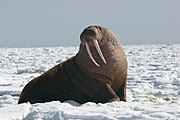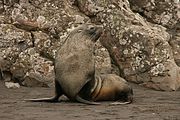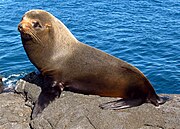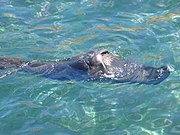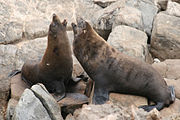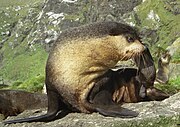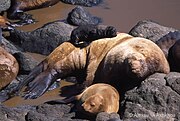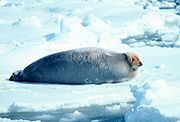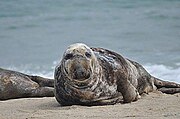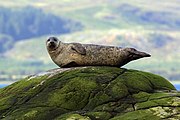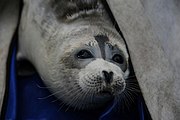List of pinnipeds
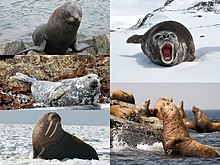
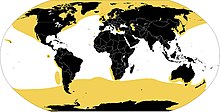
Pinnipedia is an infraorder of mammals in the order Carnivora, composed of seals, sea lions, and the walrus. A member of this group is called a pinniped or a seal.[a] They are widespread throughout the ocean and some larger lakes, primarily in colder waters. Pinnipeds range in size from the 1.1 m (3 ft 7 in) and 50 kg (110 lb) Baikal seal to the 6 m (20 ft) and 3,700 kg (8,200 lb) male southern elephant seal, which is also the largest member of Carnivora.[1] Several species exhibit sexual dimorphism, such as the southern elephant seal, where the males can be more than three times as long and six times as massive as the females, or the Ross seal, which has females typically larger than the males. Four seal species are estimated to have over one million members, while seven are classified as endangered with population counts as low as 300, and two, the Caribbean monk seal and the Japanese sea lion, went extinct in the 20th century.
The 34 extant species of Pinnipedia are split into 22 genera within 3 families: Odobenidae, comprising the walrus; Otariidae, the eared seals, split between the sea lions and fur seals; and Phocidae, the earless or true seals. Odobenidae and Otariidae are combined into the superfamily Otarioidea, with Phocidae in Phocoidea. Extinct species have also been placed into the three extant families, as well as the extinct family Desmatophocidae, though most extinct species have not been categorized into a subfamily. Nearly one hundred extinct Pinnipedia species have been discovered, though due to ongoing research and discoveries the exact number and categorization is not fixed.
Conventions
| Conservation status | |
|---|---|
| EX | Extinct (2 species) |
| EW | Extinct in the wild (0 species) |
| CR | Critically Endangered (0 species) |
| EN | Endangered (7 species) |
| VU | Vulnerable (3 species) |
| NT | Near threatened (1 species) |
| LC | Least concern (23 species) |
Conservation status codes listed follow the International Union for Conservation of Nature (IUCN) Red List of Threatened Species. Range maps are provided wherever possible; if a range map is not available, a description of the pinniped's range is provided. Ranges are based on the IUCN Red List for that species unless otherwise noted. All extinct species or subspecies listed alongside extant species went extinct after 1500 CE, and are indicated by a dagger symbol "†".
Classification
The infraorder Pinnipedia consists of 3 families containing 34 extant species belonging to 22 genera and divided into 48 extant subspecies, as well the extinct Caribbean monk seal and Japanese sea lion species, which are the only pinniped species to go extinct since prehistoric times. This does not include hybrid species or extinct prehistoric species.
- Superfamily Otarioidea
- Family Odobenidae
- Genus Odobenus: 1 species
- Family Otariidae
- Genus Arctocephalus: 8 species
- Genus Callorhinus: 1 species
- Genus Eumetopias: 1 species
- Genus Neophoca: 1 species
- Genus Otaria: 1 species
- Genus Phocarctos: 1 species
- Genus Zalophus: 3 species
- Family Odobenidae
- Superfamily Phocoidea
- Family Phocidae
- Genus Cystophora: 1 species
- Genus Erignathus: 1 species
- Genus Halichoerus: 1 species
- Genus Histriophoca: 1 species
- Genus Hydrurga: 1 species
- Genus Leptonychotes: 1 species
- Genus Lobodon: 1 species
- Genus Mirounga: 2 species
- Genus Monachus: 1 species
- Genus Neomonachus: 2 species
- Genus Ommatophoca: 1 species
- Genus Pagophilus: 1 species
- Genus Phoca: 2 species
- Genus Pusa: 3 species
- Family Phocidae
Pinnipeds
The following classification is based on the taxonomy described by Mammal Species of the World (2005), with augmentation by generally accepted proposals made since using molecular phylogenetic analysis. This includes splitting the monk seal genus Monachus into Monachus and Neomonachus, the reorganization of grey seal subspecies, and the removal of the Laptev walrus subspecies.[2][3][4]
Family Odobenidae
| Common name | Scientific name and subspecies | Range | Size and ecology | IUCN status and estimated population |
|---|---|---|---|---|
| Walrus | O. rosmarus Linnaeus, 1758 Two subspecies
|
Arctic Ocean and subarctic seas
|
Size: Male: 270–356 cm (106–140 in) long; 800–1,700 kg (1,764–3,748 lb) Female: 225–312 cm (89–123 in) long; 400–1,250 kg (882–2,756 lb)[5] Habitat: Neritic marine, oceanic marine, intertidal marine, coastal marine, and other[6] Diet: Primarily eats bivalve mollusks, as well as other invertebrates, slow-moving fish, and occasionally birds, seals, and other marine mammals[6] |
VU
|
Family Otariidae
| Common name | Scientific name and subspecies | Range | Size and ecology | IUCN status and estimated population |
|---|---|---|---|---|
| Antarctic fur seal | A. gazella Peters, 1875 |
Subantarctic islands
|
Size: Male: 180 cm (71 in) long; 130–200 kg (287–441 lb) Female: 120–140 cm (47–55 in) long; 22–50 kg (49–110 lb)[7] Habitat: Neritic marine, oceanic marine, intertidal marine, and coastal marine[7] Diet: Eats krill, cephalopods, fish, and penguins[7] |
LC
|
| Brown fur seal | A. pusillus Schreber, 1775 Two subspecies
|
Southern African and Australian coasts (dark blue indicates breeding grounds)
|
Size: Male: 201–227 cm (79–89 in) long; 218–360 kg (481–794 lb) Female: 136–171 cm (54–67 in) long; 41–113 kg (90–249 lb)[8] Habitat: Neritic marine, oceanic marine, intertidal marine, and coastal marine[8] Diet: Eat a wide variety of fish, cephalopods, and crustaceans, and sometimes African penguins and other seabirds[8] |
LC
|
| Galápagos fur seal | A. galapagoensis Heller, 1904 |
Galápagos Islands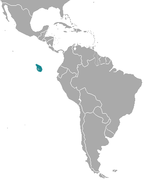
|
Size: Male: 150–160 cm (59–63 in) long; 60–68 kg (132–150 lb) Female: 110–130 cm (43–51 in) long; 27–33 kg (60–73 lb)[9] Habitat: Neritic marine, oceanic marine, intertidal marine, and coastal marine[9] Diet: Eats small squids and a variety of fish[9] |
EN
|
| Guadalupe fur seal | A. townsendi Merriam, 1897 |
Islands off of the southern Pacific coast of North America (dark blue indicates breeding grounds)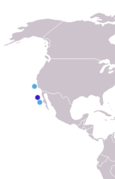
|
Size: Male: 180 cm (71 in) long; 160–170 kg (353–375 lb) Female: 148 cm (58 in) long; 49 kg (108 lb)[10] Habitat: Neritic marine, oceanic marine, intertidal marine, and coastal marine[10] Diet: Primarily eats squid, as well as fish[10] |
LC
|
| Juan Fernández fur seal | A. philippii Peters, 1866 |
Islands off of the Pacific coast of South America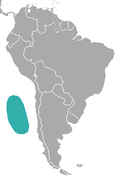
|
Size: Male: 150–200 cm (59–79 in) long; 140 kg (309 lb) Female: 140 cm (55 in) long; 50 kg (110 lb)[11] Habitat: Neritic marine, oceanic marine, intertidal marine, and coastal marine[12] Diet: Primarily eat lanternfish, as well as a narrow range of fish from the Scomberesocidae, Carangidae, Engraulidae, and Bathylagidae families, and cephalopods[12] |
LC
|
| New Zealand fur seal | A. forsteri Lesson, 1828 |
Southern Australian and New Zealand coasts
|
Size: Male: 150–250 cm (59–98 in) long; 120–180 kg (265–397 lb) Female: 100–150 cm (39–59 in) long; 30–50 kg (66–110 lb)[13] Habitat: Forest, shrubland, neritic marine, oceanic marine, intertidal marine, and coastal marine[14] Diet: Eat a wide variety of cephalopods, fish, and birds[14] |
LC
|
| South American fur seal | A. australis Zimmermann, 1783 Two subspecies
|
Southern South American coasts
|
Size: Male: 200 cm (79 in) long; 90–200 kg (198–441 lb) Female: 140 cm (55 in) long; 60 kg (132 lb)[15] Habitat: Neritic marine, oceanic marine, intertidal marine, and coastal marine[15] Diet: Primarily eat pelagic fish, demersal fish, and cephalopods[15] |
LC
|
| Subantarctic fur seal | A. tropicalis Gray, 1872 |
Southern parts of the Indian, Pacific, and Atlantic Oceans
|
Size: Male: 180 cm (71 in) long; 70–165 kg (154–364 lb) Female: 119–152 cm (47–60 in) long; 25–67 kg (55–148 lb)[16] Habitat: Neritic marine, oceanic marine, intertidal marine, and coastal marine[16] Diet: Primarily eats lanternfish, cod icefish, and cephalopods, as well as crustaceans and rockhopper penguins[16] |
LC
|
| Common name | Scientific name and subspecies | Range | Size and ecology | IUCN status and estimated population |
|---|---|---|---|---|
| Northern fur seal | C. ursinus Linnaeus, 1758 |
Northern Pacific Ocean (dark blue indicates breeding grounds)
|
Size: Male: 213 cm (84 in) long; 180–275 kg (397–606 lb) Female: 142 cm (56 in) long; 40–50 kg (88–110 lb)[17] Habitat: Neritic marine, oceanic marine, intertidal marine, and coastal marine[17] Diet: Eats a variety of epipelagic and vertically migrating mesopelagic fish and squid[17] |
VU
|
| Common name | Scientific name and subspecies | Range | Size and ecology | IUCN status and estimated population |
|---|---|---|---|---|
| Steller sea lion | E. jubatus Schreber, 1776 |
Northern Pacific Ocean (red indicates breeding grounds)
|
Size: Male: 300–340 cm (118–134 in) long; 1,120 kg (2,469 lb) Female: 230–290 cm (91–114 in) long; 350 kg (772 lb)[18] Habitat: Neritic marine, oceanic marine, intertidal marine, and coastal marine[19] Diet: Eats a variety of fish and cephalopods, as well as northern fur seal, harbor seals, and ringed seals[19] |
NT
|
| Common name | Scientific name and subspecies | Range | Size and ecology | IUCN status and estimated population |
|---|---|---|---|---|
| Australian sea lion | N. cinerea Péron, 1816 |
Southwestern Australian coast
|
Size: Male: 180–250 cm (71–98 in) long; 180–250 kg (397–551 lb) Female: 130–180 cm (51–71 in) long; 61–105 kg (134–231 lb)[20] Habitat: Neritic marine, oceanic marine, intertidal marine, and coastal marine[20] Diet: Eats cephalopods, fish, and crustaceans[20] |
EN
|
| Common name | Scientific name and subspecies | Range | Size and ecology | IUCN status and estimated population |
|---|---|---|---|---|
| South American sea lion | O. flavescens Shaw, 1800 |
Southeastern and western South American coast and islands
|
Size: Male: 210–260 cm (83–102 in) long; 300–350 kg (661–772 lb) Female: 150–200 cm (59–79 in) long; 170 kg (375 lb)[21] Habitat: Inland wetlands, neritic marine, oceanic marine, intertidal marine, and coastal marine[21] Diet: Eats a wide variety of benthic fish, pelagic fish, and invertebrates[21] |
LC
|
| Common name | Scientific name and subspecies | Range | Size and ecology | IUCN status and estimated population |
|---|---|---|---|---|
| New Zealand sea lion | P. hookeri Gray, 1844 |
Southern New Zealand coast and islands
|
Size: Male: 210–270 cm (83–106 in) long; 300–450 kg (661–992 lb) Female: 180–200 cm (71–79 in) long; 90–165 kg (198–364 lb)[22] Habitat: Forest, shrubland, neritic marine, oceanic marine, intertidal marine, and coastal marine[22] Diet: Eats a wide variety of fish, cephalopods, and crustaceans, as well as penguins[22] |
EN
|
| Common name | Scientific name and subspecies | Range | Size and ecology | IUCN status and estimated population |
|---|---|---|---|---|
| California sea lion | Z. californianus Lesson, 1828 |
Pacific North American coast (dark blue indicates breeding grounds)
|
Size: 165–220 cm (65–87 in) long; 275–390 kg (606–860 lb)[23] Habitat: Neritic marine, oceanic marine, intertidal marine, and coastal marine[24] Diet: Eats a variety of fish and squid[24] |
LC
|
| Galápagos sea lion | Z. wollebaeki Sivertsen, 1953 |
Galápagos Islands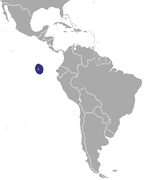
|
Size: Male: 200–250 cm (79–98 in) long; 200–400 kg (441–882 lb) Female: 150–200 cm (59–79 in) long; 50–110 kg (110–243 lb)[25] Habitat: Neritic marine, oceanic marine, intertidal marine, and coastal marine[26] Diet: Eats sardines, as well as lanternfish, deep-sea smelt, and small squid[26] |
EN
|
| Japanese sea lion† | Z. japonicus Peters, 1866 |
Sea of Japan | Size: Male: 230–250 cm (91–98 in) long; 450–560 kg (992–1,235 lb) Female: 160 cm (63 in) long[27] Habitat: Neritic marine, oceanic marine, intertidal marine, and coastal marine[27] Diet: Unknown; believed to be similar to California sea lions[27] |
EX
|
Family Phocidae
| Common name | Scientific name and subspecies | Range | Size and ecology | IUCN status and estimated population |
|---|---|---|---|---|
| Hooded seal | C. cristata Erxleben, 1777 |
Central and western North Atlantic ocean (blue indicates breeding grounds)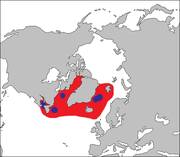
|
Size: Male: 250–270 cm (98–106 in) long; 200–400 kg (441–882 lb) Female: 200–220 cm (79–87 in) long; 145–300 kg (320–661 lb)[5] Habitat: Neritic marine, oceanic marine, intertidal marine, and coastal marine[28] Diet: Preys on fish and invertebrates throughout the water column[28] |
VU
|
| Common name | Scientific name and subspecies | Range | Size and ecology | IUCN status and estimated population |
|---|---|---|---|---|
| Bearded seal | E. barbatus Erxleben, 1777 Two subspecies
|
Arctic ocean
|
Size: 200–260 cm (79–102 in) long; 200–360 kg (441–794 lb) tail[5] Habitat: Neritic marine, oceanic marine, and intertidal marine[29] Diet: Primarily eats crabs, shrimp, clams, snails, benthic and demersal fish, and spoon worms[29] |
LC
|
| Common name | Scientific name and subspecies | Range | Size and ecology | IUCN status and estimated population |
|---|---|---|---|---|
| Grey seal | H. grypus Fabricius, 1791 Two subspecies
|
Shores of the North Atlantic Ocean
|
Size: Male: 195–230 cm (77–91 in) long; 170–310 kg (375–683 lb) Female: 165–195 cm (65–77 in) long; 105–186 kg (231–410 lb)[5] Habitat: Neritic marine, oceanic marine, intertidal marine, and coastal marine[30] Diet: Primarily eats benthic and demersal fish[30] |
LC
|
| Common name | Scientific name and subspecies | Range | Size and ecology | IUCN status and estimated population |
|---|---|---|---|---|
| Ribbon seal | H. fasciata Zimmermann, 1783 |
Arctic and subarctic regions of the North Pacific Ocean (blue indicates reduced summer range)
|
Size: 165–175 cm (65–69 in) long; 72–90 kg (159–198 lb)[31] Habitat: Neritic marine and oceanic marine[32] Diet: Preys on fish, crustaceans, and other invertebrates[32] |
LC
|
| Common name | Scientific name and subspecies | Range | Size and ecology | IUCN status and estimated population |
|---|---|---|---|---|
| Leopard seal | H. leptonyx Blainville, 1820 |
Antarctic Ocean
|
Size: Male: 250–320 cm (98–126 in) long; 200–455 kg (441–1,003 lb) Female: 241–338 cm (95–133 in) long; 225–591 kg (496–1,303 lb)[5] Habitat: Neritic marine, oceanic marine, intertidal marine, and coastal marine[33] Diet: Primarily eats krill, fish, squid, penguins, other seabirds, and juvenile seals[33] |
LC
|
| Common name | Scientific name and subspecies | Range | Size and ecology | IUCN status and estimated population |
|---|---|---|---|---|
| Weddell seal | L. weddellii Lesson, 1826 |
Coastal Antarctic Ocean
|
Size: 280–330 cm (110–130 in) long; 400–600 kg (882–1,323 lb)[34] Habitat: Neritic marine, oceanic marine, intertidal marine, and coastal marine[35] Diet: Primarily eats cod icefish, as well as Antarctic toothfish, lanternfish, and cephalopods[35] |
LC
|
| Common name | Scientific name and subspecies | Range | Size and ecology | IUCN status and estimated population |
|---|---|---|---|---|
| Crabeater seal | L. carcinophaga Hombron, Jacquinot, 1842 |
Antarctic Ocean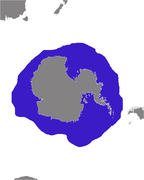
|
Size: Male: 203–241 cm (80–95 in) long; 200–300 kg (441–661 lb) Female: 216–241 cm (85–95 in) long; 200–300 kg (441–661 lb)[5] Habitat: Neritic marine, oceanic marine, intertidal marine, and coastal marine[36] Diet: Primarily eats Antarctic krill, as well as fish and squid[36] |
LC
|
| Common name | Scientific name and subspecies | Range | Size and ecology | IUCN status and estimated population |
|---|---|---|---|---|
| Northern elephant seal | M. angustirostris Gill, 1866 |
Northeastern Pacific Ocean (red dots indicate breeding grounds)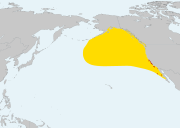
|
Size: Male: 400–500 cm (157–197 in) long; 2,000–2,700 kg (4,409–5,952 lb) Female: 200–300 cm (79–118 in) long; 600–900 kg (1,323–1,984 lb)[5] Habitat: Neritic marine, oceanic marine, intertidal marine, and coastal marine[37] Diet: Primarily eats squid, lanternfish, and other mesopelagic fish[37] |
LC
|
| Southern elephant seal | M. leonina Linnaeus, 1758 |
Antarctic and subantarctic region
|
Size: Male: 450–600 cm (177–236 in) long; 1,500–3,700 kg (3,307–8,157 lb) Female: 200–300 cm (79–118 in) long; 400–600 kg (882–1,323 lb)[5] Habitat: Neritic marine, oceanic marine, intertidal marine, and coastal marine[38] Diet: Primarily eats lanternfish, cod icefish, and squid[38] |
LC
|
| Common name | Scientific name and subspecies | Range | Size and ecology | IUCN status and estimated population |
|---|---|---|---|---|
| Mediterranean monk seal | M. monachus Hermann, 1779 |
Scattered portions of the Mediterranean Sea | Size: 230–280 cm (91–110 in) long; 240–300 kg (529–661 lb)[39] Habitat: Neritic marine, oceanic marine, intertidal marine, and coastal marine[40] Diet: Eats benthic fish, pelagic fish, cephalopods, and lobsters[39][40] |
EN
|
| Common name | Scientific name and subspecies | Range | Size and ecology | IUCN status and estimated population |
|---|---|---|---|---|
| Caribbean monk seal† | N. tropicalis Gray, 1850 |
Caribbean Sea | Size: 200–240 cm (79–94 in) long; 200 kg (441 lb)[5][39] Habitat: Neritic marine, oceanic marine, intertidal marine, and coastal marine[41] Diet: Believed to have eaten eels, lobsters, octopus, and coral reef fish[41] |
EX
|
| Hawaiian monk seal | N. schauinslandi Matschie, 1905 |
Hawaiian islands
|
Size: 210–250 cm (83–98 in) long; 170–240 kg (375–529 lb)[39] Habitat: Neritic marine, oceanic marine, intertidal marine, and coastal marine[42] Diet: Eats benthic fish, pelagic fish, cephalopods, and lobsters[39][42] |
EN
|
| Common name | Scientific name and subspecies | Range | Size and ecology | IUCN status and estimated population |
|---|---|---|---|---|
| Ross seal | O. rossii Gray, 1844 |
Coastal Antarctic Ocean
|
Size: Male: 168–208 cm (66–82 in) long; 129–216 kg (284–476 lb) Female: 190–250 cm (75–98 in) long; 159–204 kg (351–450 lb)[5] Habitat: Neritic marine, oceanic marine, and coastal marine[43] Diet: Primarily eats squid, as well as fish and krill[43] |
LC
|
| Common name | Scientific name and subspecies | Range | Size and ecology | IUCN status and estimated population |
|---|---|---|---|---|
| Harp seal | P. groenlandicus Erxleben, 1777 Two subspecies
|
Northern Atlantic Ocean
|
Size: Male: 171–190 cm (67–75 in) long; 135 kg (298 lb) Female: 168–183 cm (66–72 in) long; 120 kg (265 lb)[44] Habitat: Neritic marine, oceanic marine, intertidal marine, and coastal marine[45] Diet: Eats a wide variety of fish and invertebrates[45] |
LC
|
| Common name | Scientific name and subspecies | Range | Size and ecology | IUCN status and estimated population |
|---|---|---|---|---|
| Spotted seal | P. largha Pallas, 1811 |
Northern Pacific Ocean (dark areas indicate breeding grounds)
|
Size: Male: 161–176 cm (63–69 in) long; 85–110 kg (187–243 lb) Female: 151–169 cm (59–67 in) long; 65–115 kg (143–254 lb)[39] Habitat: Neritic marine, oceanic marine, intertidal marine, and coastal marine[46] Diet: Eats a variety of fish, cephalopods, and crustaceans[46] |
LC
|
| Harbor seal | P. vitulina Gray, 1864 Five subspecies
|
Northern Hemisphere coastlines
|
Size: Male: 160–186 cm (63–73 in) long; 87–170 kg (192–375 lb) Female: 148–169 cm (58–67 in) long; 60–142 kg (132–313 lb)[39] Habitat: Neritic marine, oceanic marine, intertidal marine, and coastal marine[47] Diet: Eats a wide variety of fish, cephalopods, and crustaceans[47] |
LC
|
| Common name | Scientific name and subspecies | Range | Size and ecology | IUCN status and estimated population |
|---|---|---|---|---|
| Baikal seal | P. sibirica Gmelin, 1788 |
Lake Baikal
|
Size: 110–140 cm (43–55 in) long; 50–130 kg (110–287 lb)[48] Habitat: Inland wetlands[48] Diet: Primarily eat sculpin fish, as well as other fish[48] |
LC
|
| Caspian seal | P. caspica Gmelin, 1788 |
Caspian Sea
|
Size: 126–140 cm (50–55 in) long; 50–86 kg (110–190 lb)[49][50] Habitat: Inland wetlands[49] Diet: Eats a variety of fish[49] |
EN
|
| Ringed seal | P. hispida Schreber, 1775 Five subspecies
|
Arctic Ocean
|
Size: 110–175 cm (43–69 in) long; 32–124 kg (71–273 lb)[51] Habitat: Inland wetlands, neritic marine, and oceanic marine[52] Diet: Eats a variety of invertebrates and small fish[52] |
LC
|
Prehistoric pinnipeds

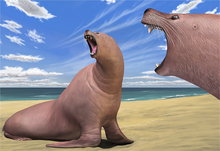



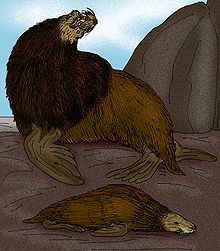
In addition to extant pinnipeds, many prehistoric species have been classified as a part of Pinnipedia. Morphogenic and molecular phylogenic research has placed them within the extant families as well as the extinct families Desmatophocidae and Panotariidae within the Otarioidea superfamily. Within Pinnipedia, prehistoric species have been placed into both extant genera and separate extinct genera. The list of fossil taxa is primarily based on the historiographical data from Valenzuela-Toro and Pyenson (2019), itself largely based on data from the Paleobiology Database, unless otherwise cited.[53] Where available, the approximate time period for the species is given in millions of years before the present (Mya), also based on data from the Paleobiology Database.[54] All listed species are extinct; where a genus or family within Pinnipedia comprises only extinct species, it is indicated with a dagger symbol †.
- Superfamily Otarioidea
- Family Odobenidae
- Genus Aivukus† (7.3–5.3 Mya)
- A. cedrosensis (7.3–5.3 Mya)
- Genus Archaeodobenus† (12–7.2 Mya)
- A. akamatsui (12–7.2 Mya)
- Genus Dusignathus† (7.3–2.5 Mya)
- D. santacruzensis (7.3–5.3 Mya)
- D. seftoni (3.6–2.5 Mya)
- Genus Gomphotaria† (7.3–5.3 Mya)
- G. pugnax (7.3–5.3 Mya)
- Genus Imagotaria† (12–10 Mya)
- I. downsi (12–10 Mya)
- Genus Kamtschatarctos (16–11 Mya)
- K. sinelnikovae (16–11 Mya)
- Genus Nanodobenus† (16–7.2 Mya)
- N. arandai (16–7.2 Mya)
- Genus Neotherium† (16–13 Mya)
- N. mirum (16–13 Mya)
- Genus Odobenus (0.79 Mya–present)
- O. mandanoensis (0.79–0.12 Mya)
- Genus Ontocetus† (4.9–0.012 Mya)
- O. emmonsi (4.9–0.012 Mya)
- Genus Osodobenus†[55]
- O. eodon[55]
- Genus Pelagiarctos† (16–13 Mya)
- P. thomasi (16–13 Mya)
- Genus Pliopedia† (5.4–3.6 Mya)
- P. pacifica (5.4–3.6 Mya)
- Genus Pontolis† (12–7.2 Mya)
- Genus Proneotherium† (21–15 Mya)
- P. repenningi (21–15 Mya)
- Genus Protodobenus† (5.4–3.6 Mya)
- P. japonicus (5.4–3.6 Mya)
- Genus Prototaria† (16–13 Mya)
- P. planicephala (16–13 Mya)
- P. primigena (16–13 Mya)
- Genus Pseudotaria† (12–7.2 Mya)
- P. muramotoi (12–7.2 Mya)
- Genus Titanotaria† (7.3–5.3 Mya)
- T. orangensis (7.3–5.3 Mya)
- Genus Valenictus† (5.4–1.8 Mya)
- V. chulavistensis (4.9–1.8 Mya)
- V. imperialensis (5.4–3.6 Mya)
- Genus Aivukus† (7.3–5.3 Mya)
- Family Otariidae
- Genus Callorhinus (7.3 Mya–present)
- C. gilmorei (3.6–1.8 Mya)
- C. inouei (7.3–3.6 Mya)
- C. macnallyae (7.3–2.5 Mya)
- Genus Hydrarctos† (7.3–5.3 Mya)
- H. lomasiensis (7.3–5.3 Mya)
- Genus Neophoca (2.6 Mya–present)
- N. palatina (Pleistocene New Zealand sea lion) (2.6–0.012 Mya)
- Genus Oriensarctos† (2.6–0.78 Mya)
- O. watasei (2.6–0.78 Mya)
- Genus Otaria (12 Mya–present)
- O. fischeri (12–7.2 Mya)
- Genus Pithanotaria† (7.3–5.3 Mya)
- P. starri (7.3–5.3 Mya)
- Genus Proterozetes† (0.79–0.12 Mya)
- P. ulysses (0.79–0.12 Mya)
- Genus Thalassoleon† (5.4–3.6 Mya)
- T. mexicanus (5.4–3.6 Mya)
- Genus Callorhinus (7.3 Mya–present)
- Family Panotariidae†
- Genus Eotaria† (21–13 Mya)
- E. circa (16–13 Mya)
- E. crypta (21–13 Mya)
- Genus Eotaria† (21–13 Mya)
- Family Odobenidae
- Superfamily Phocoidea
- Family Desmatophocidae†
- Genus Atopotarus† (21–13 Mya)
- A. courseni (21–13 Mya)
- Genus Allodesmus† (29–7.2 Mya)
- A. demerei (12–7.2 Mya)
- A. kernensis (29–13 Mya)
- A. naorai (14–11 Mya)
- A. packardi (16–11 Mya)
- A. sinanoensis (14–11 Mya)
- A. uraiporensis (16–13 Mya)
- Genus Desmatophoca† (24–15 Mya)
- D. brachycephala (24–20 Mya)
- D. oregonensis (21–15 Mya)
- Genus Eodesmus†[56]
- E. condoni[56]
- Genus Atopotarus† (21–13 Mya)
- Family Phocidae
- Genus Acrophoca† (7.3–5.3 Mya)
- A. longirostris (7.3–5.3 Mya)
- Genus Afrophoca† (21–13 Mya)
- A. libyca (21–13 Mya)
- Genus Auroraphoca† (5.4–3.6 Mya)
- A. atlantica (5.4–3.6 Mya)
- Genus Australophoca† (12–7.2 Mya)
- A. changorum (12–7.2 Mya)
- Genus Batavipusa† (12–2.5 Mya)
- B. neerlandica (12–2.5 Mya)
- Genus Callophoca† (12–2.5 Mya)
- C. obscura (12–2.5 Mya)
- Genus Cryptophoca† (14–9.7 Mya)
- C. maeotica (14–9.7 Mya)
- Genus Devinophoca† (14–11 Mya)
- D. claytoni (14–11 Mya)
- D. emryi (14–11 Mya)
- Genus Frisiphoca† (12–7.2 Mya)
- F. aberratum (12–7.2 Mya)
- F. affine (12–7.2 Mya)
- Genus Gryphoca† (16–3.6 Mya)
- G. nordica (12–3.6 Mya)
- G. similis (16–3.6 Mya)
- Genus Hadrokirus† (7.3–5.3 Mya)
- H. martini (7.3–5.3 Mya)
- Genus Histriophoca (13 Mya–present)
- H. alekseevi (13–11 Mya)
- Genus Homiphoca† (5.4–3.6 Mya)
- H. capensis (5.4–3.6 Mya)
- Genus Kawas† (12–7.2 Mya)
- K. benegasorum (12–7.2 Mya)
- Genus Leptophoca†
- L. amphiatlantica
- L. proxima (16–7.2 Mya)
- Genus Messiphoca† (7.3–5.3 Mya)
- M. mauretanica (7.3–5.3 Mya)
- Genus Miophoca† (7.3–5.3 Mya)
- M. vetusta (7.3–5.3 Mya)
- Genus Monachopsis† (12–0.78 Mya)
- M. pontica (12–0.78 Mya)
- Genus Monotherium† (12–7.2 Mya)
- M. delognii (12–7.2 Mya)
- Genus Nanophoca† (12–3.6 Mya)
- N. vitulinoides (12–3.6 Mya)
- Genus Noriphoca† (24–20 Mya)
- N. gaudini (24–20 Mya)
- Genus Pachyphoca† (14–7.2 Mya)
- P. chapskii (14–11 Mya)
- P. ukrainica (12–7.2 Mya)
- Genus Palmidophoca† (16–13 Mya)
- P. callirhoe (16–13 Mya)
- Genus Phoca (3.6 Mya–present)
- P. moori (3.6–2.5 Mya)
- Genus Phocanella† (5.4–3.6 Mya)
- P. pumila (5.4–3.6 Mya)
- Genus Piscophoca† (7.3–5.3 Mya)
- P. pacifica (7.3–5.3 Mya)
- Genus Platyphoca† (12–3.6 Mya)
- P. danica (12–7.2 Mya)
- P. vulgaris (5.4–3.6 Mya)
- Genus Pliophoca† (5.4–2.5 Mya)
- P. etrusca (5.4–2.5 Mya)
- Genus Pontophoca†
- P. jutlandica (12–7.2 Mya)
- P. sarmatica (13–11 Mya)
- P. simionescui (13–7.2 Mya)
- Genus Praepusa†
- P. archankutica
- P. boeska (5.4–3.6 Mya)
- P. magyaricus (13–11 Mya)
- P. pannonica (13–11 Mya)
- P. vindobonensis (14–0.78 Mya)
- Genus Pristiphoca†
- P. occitana (16–2.5 Mya)
- P. rugidens
- Genus Properiptychus† (14–11 Mya)
- P. argentinus (14–11 Mya)
- Genus Prophoca† (16–0.012 Mya)
- P. rousseaui (16–0.012 Mya)
- Genus Sarmatonectes† (13–11 Mya)
- S. sintsovi (13–11 Mya)
- Genus Terranectes† (12–5.3 Mya)
- T. magnus (12–5.3 Mya)
- T. parvus (12–5.3 Mya)
- Genus Virginiaphoca†(12–3.6 Mya)
- V. magurai (12–3.6 Mya)
- Genus Acrophoca† (7.3–5.3 Mya)
- Family Desmatophocidae†
Notes
- ^ "Seal" can refer to the entire pinniped infraorder, but is often also used to mean either pinnipeds with the exception of the walrus, or fur seals and true seals while excluding the walrus and sea lions.
References
- ^ "Southern Elephant Seal". Marine Life Encyclopedia. Oceana. Archived from the original on January 24, 2020. Retrieved December 1, 2020.
- ^ Scheel, D.-M.; Slater, G. J.; Kolokotronis, S.-O.; Potter, C. W.; Rotstein, D. S.; Tsangaras, K.; Greenwood, A. D.; Helgen, K. M. (May 2014). "Biogeography and taxonomy of extinct and endangered monk seals illuminated by ancient DNA and skull morphology". ZooKeys (409): 1–33. doi:10.3897/zookeys.409.6244. PMC 4042687. PMID 24899841.
- ^ Olsen, M. T.; Galatius, A.; Biard, V.; Gregersen, K.; Kinze, C. C. (April 2016). "The forgotten type specimen of the grey seal [Halichoerus grypus (Fabricius, 1791)] from the island of Amager, Denmark". Zoological Journal of the Linnean Society. 178 (3): 713–720. doi:10.1111/zoj.12426.
- ^ Higdon, J. W.; Stewart, D. B. (2018). State of Circumpolar Walrus Populations: Odobenus rosmarus (PDF). WWF Arctic Programme. p. 6. Archived (PDF) from the original on November 9, 2020. Retrieved November 9, 2020.
- ^ a b c d e f g h i j Nowak, Ronald M.; Walker, Ernest Pillsbury (2003). Walker's Marine Mammals of the World. Johns Hopkins University Press. pp. 92–113. ISBN 978-0-8018-7343-0.
- ^ a b c Lowry, L. (2016). "Odobenus rosmarus". IUCN Red List of Threatened Species. 2016: e.T15106A45228501. doi:10.2305/IUCN.UK.2016-1.RLTS.T15106A45228501.en.
- ^ a b c d Hofmeyr, G. J. G. (2016). "Arctocephalus gazella". IUCN Red List of Threatened Species. 2016: e.T2058A66993062. doi:10.2305/IUCN.UK.2016-1.RLTS.T2058A66993062.en.
- ^ a b c d Hofmeyr, G. J. G. (2015). "Arctocephalus pusillus". IUCN Red List of Threatened Species. 2015: e.T2060A45224212. doi:10.2305/IUCN.UK.2015-4.RLTS.T2060A45224212.en.
- ^ a b c d Trillmich, F. (2015). "Arctocephalus galapagoensis". IUCN Red List of Threatened Species. 2015: e.T2057A45223722. doi:10.2305/IUCN.UK.2015-2.RLTS.T2057A45223722.en.
- ^ a b c d Aurioles-Gamboa, D. (2015). "Arctocephalus townsendi". IUCN Red List of Threatened Species. 2015: e.T2061A45224420. doi:10.2305/IUCN.UK.2015-2.RLTS.T2061A45224420.en.
- ^ Handysides, Daniel (2004). "Arctocephalus philippii". Animal Diversity Web. University of Michigan. Archived from the original on August 2, 2020. Retrieved November 17, 2020.
- ^ a b c Aurioles-Gamboa, D. (2015). "Arctocephalus philippii". IUCN Red List of Threatened Species. 2015: e.T2059A61953525. doi:10.2305/IUCN.UK.2015-2.RLTS.T2059A61953525.en.
- ^ Landgren, Dorothy (2013). "Arctocephalus forsteri". Animal Diversity Web. University of Michigan. Archived from the original on November 13, 2020. Retrieved November 17, 2020.
- ^ a b c Chilvers, B. L.; Goldsworthy, S. D. (2015). "Arctocephalus forsteri". IUCN Red List of Threatened Species. 2015: e.T41664A45230026. doi:10.2305/IUCN.UK.2015-2.RLTS.T41664A45230026.en.
- ^ a b c d Cárdenas-Alayza, S.; Oliveira, L.; Crespo, E. (2016). "Arctocephalus australis". IUCN Red List of Threatened Species. 2016: e.T2055A45223529. doi:10.2305/IUCN.UK.2016-1.RLTS.T2055A45223529.en.
- ^ a b c d Hofmeyr, G. J. G. (2015). "Arctocephalus tropicalis". IUCN Red List of Threatened Species. 2015: e.T2062A45224547. doi:10.2305/IUCN.UK.2015-4.RLTS.T2062A45224547.en.
- ^ a b c d Gelatt, T.; Ream, R.; Johnson, D. (2015). "Callorhinus ursinus". IUCN Red List of Threatened Species. 2015: e.T3590A45224953. doi:10.2305/IUCN.UK.2015-4.RLTS.T3590A45224953.en.
- ^ Keranen, Danielle (2013). "Eumetopias jubatus". Animal Diversity Web. University of Michigan. Archived from the original on October 30, 2020. Retrieved November 16, 2020.
- ^ a b c Gelatt, T.; Sweeney, K. (2016). "Eumetopias jubatus". IUCN Red List of Threatened Species. 2016: e.T8239A45225749. doi:10.2305/IUCN.UK.2016-1.RLTS.T8239A45225749.en.
- ^ a b c d Goldsworthy, S. D. (2015). "Neophoca cinerea". IUCN Red List of Threatened Species. 2015: e.T14549A45228341. doi:10.2305/IUCN.UK.2015-2.RLTS.T14549A45228341.en.
- ^ a b c d Cárdenas-Alayza, S.; Crespo, E.; Oliveira, L. (2016). "Otaria byronia". IUCN Red List of Threatened Species. 2016: e.T41665A61948292. doi:10.2305/IUCN.UK.2016-1.RLTS.T41665A61948292.en.
- ^ a b c d Chilvers, B. L. (2015). "Phocarctos hookeri". IUCN Red List of Threatened Species. 2015: e.T17026A1306343. doi:10.2305/IUCN.UK.2015-2.RLTS.T17026A1306343.en.
- ^ "California Sea Lion". National Geographic. 10 May 2011. Archived from the original on November 9, 2020. Retrieved November 24, 2020.
- ^ a b c Aurioles-Gamboa, D.; Hernández-Camacho, J. (2015). "Zalophus californianus". IUCN Red List of Threatened Species. 2015: e.T41666A45230310. doi:10.2305/IUCN.UK.2015-4.RLTS.T41666A45230310.en.
- ^ "Galapagos sea lion (Zalophus wollebaeki)". ARKive. Wildscreen. Archived from the original on September 21, 2020. Retrieved November 24, 2020.
- ^ a b c Trillmich, F. (2015). "Zalophus wollebaeki". IUCN Red List of Threatened Species. 2015: e.T41668A45230540. doi:10.2305/IUCN.UK.2015-2.RLTS.T41668A45230540.en.
- ^ a b c d Lowry, L. (2017) [amended version of 2015 assessment]. "Zalophus japonicus". IUCN Red List of Threatened Species. 2017: e.T41667A113089431. doi:10.2305/IUCN.UK.2017-1.RLTS.T41667A113089431.en.
- ^ a b c Kovacs, K. M. (2016). "Cystophora cristata". IUCN Red List of Threatened Species. 2016: e.T6204A45225150. doi:10.2305/IUCN.UK.2016-1.RLTS.T6204A45225150.en.
- ^ a b c Kovacs, K. M. (2016). "Erignathus barbatus". IUCN Red List of Threatened Species. 2016: e.T8010A45225428. doi:10.2305/IUCN.UK.2016-1.RLTS.T8010A45225428.en.
- ^ a b c Bowen, D. (2016). "Halichoerus grypus". IUCN Red List of Threatened Species. 2016: e.T9660A45226042. doi:10.2305/IUCN.UK.2016-1.RLTS.T9660A45226042.en.
- ^ Berry, Ben; Townsend, Kelsey (2012). "Histriophoca fasciata". Animal Diversity Web. University of Michigan. Archived from the original on November 9, 2020. Retrieved October 28, 2020.
- ^ a b c Lowry, L. (2016). "Histriophoca fasciata". IUCN Red List of Threatened Species. 2016: e.T41670A45230946. doi:10.2305/IUCN.UK.2016-1.RLTS.T41670A45230946.en.
- ^ a b c Hückstädt, L. (2015). "Hydrurga leptonyx". IUCN Red List of Threatened Species. 2015: e.T10340A45226422. doi:10.2305/IUCN.UK.2015-4.RLTS.T10340A45226422.en.
- ^ Burnie, David; Wilson, Don E., eds. (2017). Animal. DK. p. 184. ISBN 978-1-4654-7086-7.
- ^ a b c Hückstädt, L. (2015). "Leptonychotes weddellii". IUCN Red List of Threatened Species. 2015: e.T11696A45226713. doi:10.2305/IUCN.UK.2015-4.RLTS.T11696A45226713.en.
- ^ a b c Hückstädt, L. (2015). "Lobodon carcinophaga". IUCN Red List of Threatened Species. 2015: e.T12246A45226918. doi:10.2305/IUCN.UK.2015-4.RLTS.T12246A45226918.en.
- ^ a b c Hückstädt, L. (2015). "Mirounga angustirostris". IUCN Red List of Threatened Species. 2015: e.T13581A45227116. doi:10.2305/IUCN.UK.2015-2.RLTS.T13581A45227116.en.
- ^ a b c Hofmeyr, G. J. G. (2015). "Mirounga leonina". IUCN Red List of Threatened Species. 2015: e.T13583A45227247. doi:10.2305/IUCN.UK.2015-4.RLTS.T13583A45227247.en.
- ^ a b c d e f g Würsig, Bernd (2009). Encyclopedia of Marine Mammals. Elsevier Science. pp. 533–534, 741. ISBN 978-0-08-091993-5.
- ^ a b c Karamanlidis, A.; Dendrinos, P. (2015). "Monachus monachus". IUCN Red List of Threatened Species. 2015: e.T13653A45227543. doi:10.2305/IUCN.UK.2015-4.RLTS.T13653A45227543.en.
- ^ a b c Lowry, L. (2015). "Neomonachus tropicalis". IUCN Red List of Threatened Species. 2015: e.T13655A45228171. doi:10.2305/IUCN.UK.2015-2.RLTS.T13655A45228171.en.
- ^ a b c Littnan, C.; Harting, A.; Baker, J. (2015). "Neomonachus schauinslandi". IUCN Red List of Threatened Species. 2015: e.T13654A45227978. doi:10.2305/IUCN.UK.2015-2.RLTS.T13654A45227978.en.
- ^ a b c Hückstädt, L. (2015). "Ommatophoca rossii". IUCN Red List of Threatened Species. 2015: e.T15269A45228952. doi:10.2305/IUCN.UK.2015-4.RLTS.T15269A45228952.en.
- ^ McKenna, Alison (2009). "Pagophilus groenlandicus". Animal Diversity Web. University of Michigan. Archived from the original on August 1, 2020. Retrieved November 16, 2020.
- ^ a b c Kovacs, K. M. (2015). "Pagophilus groenlandicus". IUCN Red List of Threatened Species. 2015: e.T41671A45231087. doi:10.2305/IUCN.UK.2015-4.RLTS.T41671A45231087.en.
- ^ a b c Boveng, P. (2016). "Phoca largha". IUCN Red List of Threatened Species. 2016: e.T17023A45229806. doi:10.2305/IUCN.UK.2016-1.RLTS.T17023A45229806.en.
- ^ a b c Harvey, J. (2016). "Phoca vitulina ssp". IUCN Red List of Threatened Species. 2016: e.T17022A66991556. doi:10.2305/IUCN.UK.2016-1.RLTS.T17022A66991556.en.
- ^ a b c d Goodman, S. (2016). "Pusa sibirica". IUCN Red List of Threatened Species. 2016: e.T41676A45231738. doi:10.2305/IUCN.UK.2016-1.RLTS.T41676A45231738.en.
- ^ a b c d Goodman, S.; Dmitrieva, L. (2016). "Pusa caspica". IUCN Red List of Threatened Species. 2016: e.T41669A45230700. doi:10.2305/IUCN.UK.2016-1.RLTS.T41669A45230700.en.
- ^ Easley-Appleyard, Bonnie (2006). "Pusa caspica". Animal Diversity Web. University of Michigan. Archived from the original on July 27, 2020. Retrieved November 16, 2020.
- ^ Spicer, Rebekah (2013). "Pusa hispida". Animal Diversity Web. University of Michigan. Archived from the original on August 6, 2020. Retrieved November 17, 2020.
- ^ a b c Lowry, L. (2016). "Pusa hispida". IUCN Red List of Threatened Species. 2016: e.T41672A45231341. doi:10.2305/IUCN.UK.2016-1.RLTS.T41672A45231341.en.
- ^ Valenzuela-Toro, A.; Pyenson, N. D. (2019). "What do we know about the fossil record of pinnipeds? A historiographical investigation". Royal Society Open Science. 6 (11): 207–234. Bibcode:2019RSOS....691394V. doi:10.1098/rsos.191394. PMC 6894555. PMID 31827869.
- ^ "Fossilworks: Pinnipedia". Paleobiology Database. University of Wisconsin–Madison. Retrieved December 17, 2021.
- ^ a b c d Biewer, J. N.; Velez-Juarbe, J.; Parham, J. F. (2020). "Insights on the dental evolution of walruses based on new fossil specimens from California". Journal of Vertebrate Paleontology. 40 (5): e1833896. doi:10.1080/02724634.2020.1833896.
- ^ a b Tate-Jones, M. K.; Peredo, C. M.; Marshall, C. D.; Hopkins, S. S. B. (2020). "The Dawn of Desmatophocidae: A New Species of Basal Desmatophocid Seal (Mammalia, Carnivora) from the Miocene of Oregon, U.S.A.". Journal of Vertebrate Paleontology. 40 (4): e1789867. doi:10.1080/02724634.2020.1789867.

